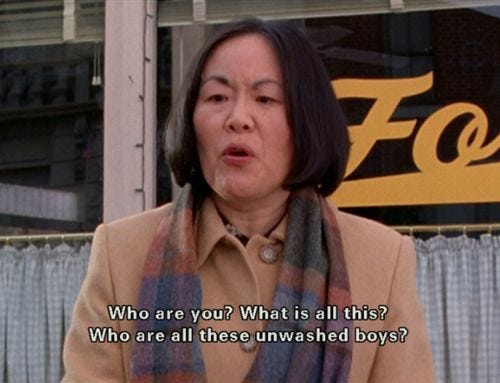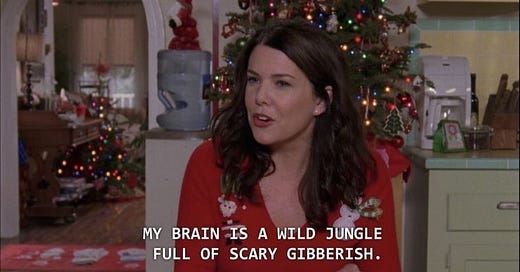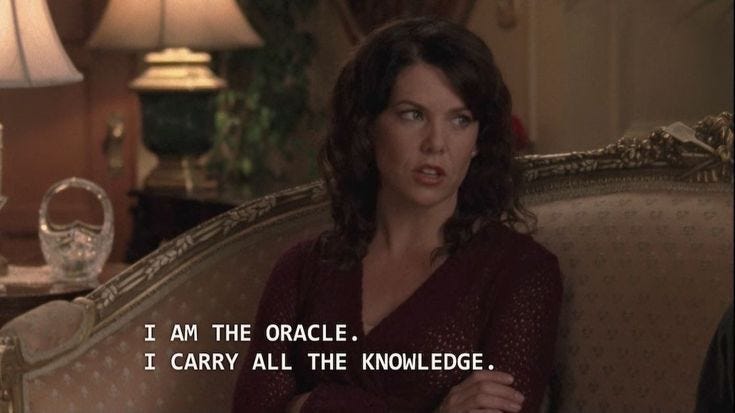Logging Off: The Great Social Media Escape
A Chronically Online Person's Attempt to Disconnect for a Week
The First Step is Admitting You Have a Problem
Like many such initiatives start in my life, the decision to bestow a Social Media ban upon myself came in a moment of self-reflection. ‘Twas a peaceful Sunday night in my small Copenhagen apartment, I’d just sat down in front of the TV and turned on an episode of Gilmore girls that I wasn’t really going to watch because I planned to scroll through Instagram Reels at the same time, and then - PING. The scariest notification of all popped up on my feed. I’m talking, of course, of the weekly occurrence when your iPhone does you a solid and generates a report showing you just how much time you’ve wasted that week. On this occasion, my average daily screen time was just shy of 10 hours, with a record-breaking 15 hours logged on Monday alone.
I’d been aware of my Social Media addiction since 2020, when I’d first created an account on TikTok during the Covid-19 lockdown. I was no stranger to going over the recommended screen time limit before that, but prior to lockdown, I felt I had control over it; something I’d completely lost after engaging with the TikTok algorithm. And of course - this made sense. Confined to our homes, unable to meet even those closest to us, there were few things that made us feel as connected to other human beings as the constant snippets of their lives arranged in an endless loop of TikTok videos. Even as I write this now, just a few months short of lockdown’s 5th anniversary, I am nostalgic about the time when I virtually followed along as people renovated their homes, made those super-foamy dalgona coffees, and announced that they had written the song of the summer from the driver’s seats of their cars in empty parking lots.
In preparation for this piece, I’ve looked at the research done over the last couple of years and unsurprisingly found I was not the only one whose Social Media addiction grew with the rise of TikTok during the global pandemic. In March of 2020, during the first month of lockdown, the number of TikTok downloads surged to a whopping 115 million, showing just how eager we all were to fill the void of isolation. Another research shows that during this time, a correlation between psychological disorders such as anxiety and chronic loneliness, and cyber addiction to TikTok became apparent in the way people started relying on the app to seek comfort and avoid negative emotions. TikTok and its mother company ByteDance undoubtedly capitalised on our collective emotional disgruntlement, but more than that, the success of their algorithm and their, at the time, uniquely structured feed completely transformed other apps in this space. Instagram, Facebook, YouTube, and even Pinterest have adopted the short-form video-based scrollable feed, steadily becoming as addictive as their predecessor.
All of this is to say, the terrifying figures I’d found in the Screen Time statistics of my iPhone represented a culmination of years of seeking emotional comfort by using short-form content to overwhelm my brain into silence. Without intending to do so, I’ve made scrolling my default response to anxiety and unease, until it became my primary impulse in any given situation. The first thing I did each morning and the last thing I did each night was scroll. And then I thought: what if I just stop?
Rules of Engagement (or Disengagement)
Like with any good experiment, my SoMe detox needed rules. These were the ones that made the cut:
Setting up a realistic time frame for the detox. I knew if I aimed too high, my motivation would wear off, so I decided one week was optimal.
Deleting all apps with a scrollable feed. This in my case included Facebook, Instagram, TikTok, Pinterest, and Reddit.
Aiming for less than 2 hours of screen time each day. Anything below this would in my case have been unrealistic, given I still needed my phone to communicate with my partner, family, and friends, and most importantly, keep my Duolingo streak alive.
Not touching my phone for at least an hour before bed. This included no messaging, no Spotify, no Duolingo. One hour before bed, I’d set my alarm clock for the next morning, and then leave my phone aside, not to be touched until that alarm rang.
Finally, and this one is controversial - I did allow myself 5 minutes to open Instagram on my laptop each day. In the past, my attempted SoMe bans usually failed for one reason - I’d get insatiable FOMO thinking that people might be trying to reach me via Instagram (my most used social app), and I’d end up downloading it back onto my phone to check. By allowing myself to check my messages daily, I made sure to eliminate that cue.
In my case, there was really no need to make the rules more complex than this. Once I had formulated and inked them into my journal, my week of doom scroll detox begun, and to my huge surprise - it wasn’t nearly as difficult as I expected.
Life Beyond the Feed: The Debrief
The impact of reducing the amount of time I usually wasted on scrolling was noticeable almost instantly. By mid-week, I was amazed at how much longer my days felt, and how much more activity I could squeeze into them. Projects I’ve shelved over the last months were in motion again. I didn’t procrastinate on my workouts and I found it was possible to find time for being outdoors every day, even if its only for a 20 minute walk.
But it wasn’t all sunshine and daisies. As someone suffering from anxiety, taking away a reliable source of dopamine left me struggling in situations where all my distractions were taken away. This mostly affected me at nighttime; when the lights went off and I could no longer read my book, my fingers started itching for my phone and a scrollable feed I could look at until the sleep came. I also found that without my phone as a secondary source of stimulation, watching television was no longer relaxing, and quite often I would find myself wiggling my foot or tapping my fingers against the couch cushions, as I often do when I’m anxious.
On the last day of my experiment, I’d sat down and written the observations I made into my journal, which I will now transcribe for you here.
The Positives:
My days started feeling much fuller, as I was now able to fill the time usually spent on my phone with multiple different activities. For comparison, on a regular day pre-ban, my day would consist of going to work, working out if I had the energy to, and spending my evening on the couch, glued to my phone, watching reruns of one of my comfort shows (usually one of the holy trinity: Grey’s Anatomy, Gilmore girls, or Sex and the City). Now that scrolling was not an option, I found the time for the interests I would usually leave for weekends: writing, scrapbooking, crocheting - all of them creative work, you’ll notice. Apart from the glaringly obvious benefit of creating something, spending my time on productive tasks also meant I would go to bed each night with a sense of fulfilment I had normally lacked.
Another benefit I noticed pretty early on was how much more intentional I became in my decision making. When I wasn’t in a constant race with time, I found that I made much healthier choices, especially when it came to movement and nutrition. Moving my body and ensuring I fuel it properly is a big struggle of mine, particularly when it comes to the time-consuming nature of cooking, meal-prepping and cleaning up the mess that inevitably followed. Freeing up more hours in my day made cooking seem less daunting. I stopped procrastinating until the last moment and felt reassured knowing I’d still have time for the activities I enjoyed after preparing my meals.
I stopped identifying as lazy. Years of losing endless hours to scrolling and having my days follow the standard formula of work + exercise + rot on the couch made me think of myself as a lazy person. With an ever-present window into (unrealistic) lives of people who seemed to do much more than me, the only logical conclusion was that I just wasn’t one of them. When I took away the scrolling, I realised that wasn’t the case. The cause to my laziness was the fact that I spent all my time comparing myself to those hyper-productive what-I-do-in-a-day videos, planning the life that I was never going to live as long as I was too busy perfecting the plan. Once I was no longer able to look for inspiration (and validation) externally, I learned the only ingredient I needed to snap out of my inertia was the time that my SoMe ban was now giving back to me.
I’ve reignited my passions. This one’s pretty straightforward; with no access to Social Media, I was no longer able to compare my creative projects to what other people shared online. I wasn’t able to look at other creative accounts and think: well, I’ll never be this good, so I might as well give up. Naturally, this brought joy back into my creative process, and I found I was inspired to write almost daily, where before my inspiration struck rather haphazardly, and was easily eviscerated by the sight of something better.
The Negatives:
For me, positive outcomes of this exploration massively outweighed the negative ones. There is only one thing I want to list in this section, and there is a massive proverbial asterisks on it. I’m talking - of course - about my anxiety. Over the period of seven days of eliminating scrolling from my life, I experienced more frequent anxiety spikes, particularly during nighttime, leading to subsequently lower quality of sleep. While this was definitely not a fun side effect to deal with, I did expect it would be the case. Not being able to scroll through my TikTok feed before bed, as my brain had been used to doing for the last several years, put me in a state of withdrawal. There was never any chance of me learning how to overcome this in such a limited time period, so while it did objectively suck, it didn’t tarnish the experience for me.
Post-Social Clarity
To close off this one-sided discussion on the impacts of Social Media consumption, I thought I would answer some questions you are bound to have if you made it this far.
Q: Did my week offline change how (much) I interact with Social Media?
A: Sadly, no. Not yet, at least. I too have hoped that after a week of seeing the consequences of my addiction with my own eyes, I would be cured - but sadly, that’s not how addictions work. As soon as I re-downloaded the applications, my screen time went back to concerning heights.
Q: Does that mean all hope is lost?
A: Also not. The first few weeks after re-downloading have shown that my instinct remains the same when it comes to SoMe, as long as the option is available - I am inclined to scroll. However, having increased my awareness of it, and having proven to myself that I actually can spend my time differently, I am now more mindful with how I choose to spend my time on- and offline. I am still a long way away from a healthy balance, but I notice that I’m incrementally reclaiming my time. I’ve now permanently deleted TikTok and replaced it with Substack, ensuring that the time spent scrolling is at least spent reading and exploring new subjects and viewpoints. My Achilles’ heel remains Instagram, but I’m trying to get that under control by limiting my access to the app to one and a half hour a day, hoping to lower that limit as I adjust.

Q: Would I do this kind of a detox again?
A: Absolutely - and I probably will. Being disconnected from the online world made my foothold in the real, physical one, feel much stronger.
Q: Do I have any advice for those of you who would like to do the same?
A: This doesn’t have to be an all-or-nothing kind of deal. By giving myself 5 minutes every day to log into my Instagram on desktop and check my messages, I made this whole challenge so much easier and eliminated the temptation to re-download. Change is difficult, and it's okay to tweak the circumstances in your favour if it helps achieve the overall goal.






